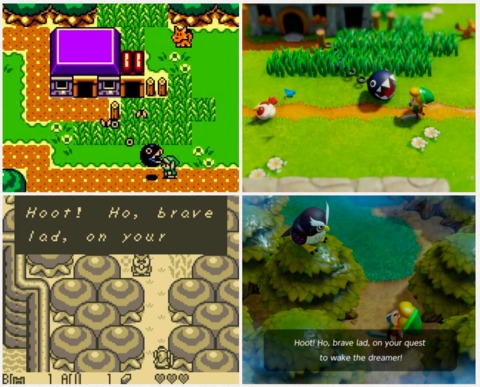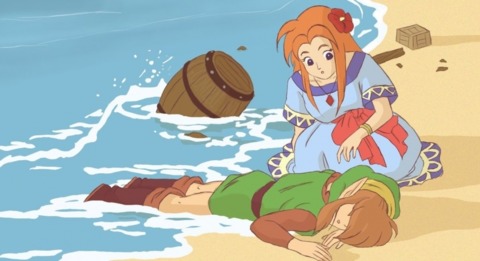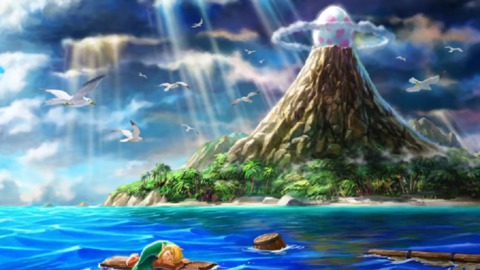The Legend of Zelda is a peerless series—an eternal, unrolling scroll of primal belief and Campbellian myth made flesh via the grace of our digital age. Indeed, the “Zeldaverse” has become both a refuge and lifestyle choice for those hopeful disciples seeking meaning, or, at least, a sense of wonder, in a world seemingly bereft of either. Yes, fans love the franchise for its matchless adventure and epic action. But it’s the mythology more than the mechanics that feeds their continued devotion, shepherding the faithful with an ever-flowing tome of new revelation thanks to its constant updates and reimaginings.
The celebrated Link’s Awakening is no different, existing as Nintendo’s latest attempt in remaking one of the series’ greatest, most provocative tales. No doubt, with all its narrative potential, the Game Boy classic is perhaps among the few in the franchise to truly justify another try—a second quest, one might say, in better developing the story’s deeper meanings. And yet, if early previews are to be believed, the Big N seems content in merely repeating the same narrative beats as before, focusing more on the game’s new glossy graphics than the darker drama awaiting within.
One hopes to be wrong in daring such heresy, but for now, Awakening’s modern return is seeming more rerun than epic retelling.

The Original’s Promise, the Remake’s Problem
Link’s Awakening stands unique as the series’ grand tragedy, even when “victory” is finally achieved by the saga’s end. Indeed, no other Zelda entry is more steeped in the blur between dream and nightmare, in absurdist whimsy and existential misery, of hope and dread and the cruel, dual nature of reality. The Game Boy original sees the hapless hero stranded upon the mysterious Koholint Island where a cast of eccentric villagers, anthropomorphic animals, mythical beings, and brazen monsters all co-exist. Most significant, however, is the mysterious “Wind Fish,” a creature slumbering within a giant, impenetrable egg. Awakening this dubious dreamer might be Link’s only hope in returning home. But if he does, so warns a wizened owl, what happens to the island? What if everything Link has experienced is the mere projection of a god’s unraveling fantasy?
Hence the game’s moral conundrum; is the island so ephemeral as to be expendable? Can Link, in good faith, sacrifice all those friendly faces in exchange for a ticket to freedom? If everything is a mere illusion, are the islanders’ lives thus meaningless and thereby irrelevant? Who has the right to decide, if anyone, what’s real and what’s fiction? Moreover, what makes the owl so uniquely trustworthy? Can the “enemy” nightmares really be blamed for protecting their own tenuous existence? Shouldn’t Link, the virtuous hero, strive for a solution that will spare the lives of all involved? Or conversely, could the hero himself be the actual villain, a puppet controlled by sinister, invisible hands?

Caught in this drama is the radiant Marin, a girl whose charm and beauty rivals the goddesses themselves. The girl who, incidentally, saves Link’s life, and who also dreams of leaving the island behind. Indeed, an immaculate woman any man would proudly die for.
Except Link, apparently. Here, his role of protector is grossly subverted—only by sacrificing his would-be love, and countless others, can he hope to escape his otherwise paradise. Yep, with a proverbial snap, he can make it all go away. Such is the tragedy—the squirmy, sticky reality—that festers at the game’s murky center.
At least in theory…

Regretfully, these darker elements are more suggested than explored in the original telling, obscured by the title’s emphasis on whimsy and outlandish absurdity. A missed opportunity, indeed, for an otherwise gripping game. And why, ever since, Zelda acolytes have pined for a second take—another chance for Nintendo to get the story right, to finally explore those darker corners barely acknowledged before. Alas, judging from early footage, the remake looks to follow the original’s script almost to the letter, leaving little space to examine those darker themes always hinted in the subtext, waiting to be awakened, as it were.
Remakes come in two forms—those that mirror their predecessors, and those that build on the original’s core. Link’s Awakening has chosen the former road, it seems, interested mainly in updating its visuals—an admittedly charming, if superficial, veneer that succeeds only in demeaning the story’s darker implications.
This is a travesty; a waste of a second chance. And why, if early signs prove true, this is one remake best left to the past.--PAC
Want a deeper look into this topic? Please seek my weekly podcast here. For this particular episode, I elaborate more on Awakening's cute but tonally questionable graphics.
Thanks to Nintendosoup.com for the comparison image.
Log in to comment